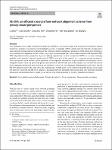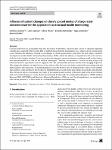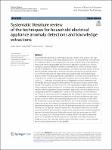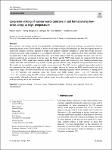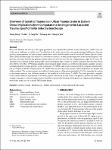Search
Author
- Amir, Ebrahimi (2)
- Aydin, Azizi (2)
- George, Haller (2)
- James, M. Fiore (2)
- next >
Subject
- Engineering (4)
- công nghệ (3)
- kỹ thuật (3)
- Robotics (3)
- next >
Date issued
Has File(s)
- true (215)
Search Results
Geopolymer concrete (GPC) was developed using one-part binders made from a mixture of waste clay brick (WCB) powder, fly ash, and slag in the precursor. Its suitability for use in rigid pavement construction was evaluated based on fresh properties, hardened properties, and durability characteristics. The effects of sealed and unsealed ambient curing and the size of the WCB particles on the strength of the GPC were also examined. Sealed ambient curing significantly increased the strength of the GPC, with longer sealing periods resulting in even stronger concrete. Sealing prevented water loss from the samples and reduced carbonation, protecting the concrete from microcracks caused by dehydration. The GPC created in this study met the basic strength requirements for use in rigid paveme... |
User alignment across online social network platforms (OSNPs) is a growing concern with the rapid development of internet technology. In reality, users tend to register different accounts on multiple OSNPs, and the network platforms are reluctant to share network structure and user’s information due to business interest and privacy protection, which brings great obstacles to cross-platform user alignment. In view of this, we propose a homomorphic encryption-based social network alignment (HE-SNA) algorithm from the perspective of privacy leakage. Specifically, we first consider the OSNPs as a system containing multiple social networks, that each participant of OSNPs owns part of the network, i.e., a separate private sub-network. |
Concrete steel towers are increasingly being used for onshore wind turbines. The lower part consists of separated segmented concrete rings connected with dry joints. Due to slight deviations from the axisymmetric cross-section, closely spaced modes occur. Therefore, the influences of small system changes on closely spaced modes, particularly the mode shapes, should be investigated to enable reliable vibration-based monitoring. In this context, the influence of imperfections due to the waviness of the dry joints requires attention. As no acceleration measurements on concrete towers considering small system changes have been performed so far, this has not yet been investigated. |
The demand for electricity at home has increased in recent times globally, this high demand for continuous, stable and affordable power can be attributed to the demand for comfortable lifestyle of consumers but the quality and efficiency of the appliances being used remain questionable. Malfunctioning appliances usually show a power signature statistically different from their normal behavior, which can lead to higher energy consumption or more serious damages. As a result, numerous studies in recent times have been conducted on the household electrical appliance anomaly behaviors to find the root-cause of these anomalies using machine learning techniques and algorithms. |
Rock salt has a self-sealing capacity, low permeability, and high thermal conductivity, making it a potential host for heat-generating nuclear waste. The feasibility of nuclear waste disposal within salt formations has been investigated mostly for small-sized canisters. Geologic disposal of larger-sized canisters originally designed for spent fuel storage and transportation has lately been examined as a cost-effective alternative. This raises questions about their long-term vertical movement due to their weight and high decay heat. Low-stress creep governs this movement; however, most salt constitutive models do not incorporate it. In this paper, the Norton and the WIPP creep models are compared with the Lux/Wolters/Lerche (LWL) model and a simpler model that combines linear and Nor... |
The facial and physiological sensor-based emotion recognition methods are two popular methods of emotion recognition. The proposed research is the first of its kind in real-time emotion recognition that combines skin conductance signals with the visual-based facial emotion recognition (FER) method on a Raspberry Pi. This research includes stepwise documentation of method for automatic real-time face detection and FER on portable hardware. Further, the proposed work comprises experimentation related to video induction and habituation methods with FER and the galvanic skin response (GSR) method. |
The paper presents a rigorous formulation of adjoint systems to be solved for a robust design optimization using the first-order second-moment method. This formulation allows to apply the method for any objective function, which is demonstrated by considering deformation at certain point and maximum stress as objectives subjected to random material stiffness and geometry, respectively. The presented approach requires the solution of at most three additional adjoint systems per uncertain system response, when compared to the deterministic case. Hence, the number of adjoint systems to be solved is independent of the number of random variables. |
Numerous tribological applications, wherein the use of liquid lubricants is infeasible, require adequate dry lubrication. Despite the use of polymers as an effective solution for dry sliding tribological applications, their poor wear resistance prevents the utilization in harsh industrial environment. Different methods are typically implemented to tackle the poor wear performance of polymers, however sacrificing some of their mechanical/ tribological properties. Herein, we discussed the introduction of a novel additive, namely microencapsulated phase change material (MPCM) into an advanced polymeric coating. Specifically, paraffin was encapsulated into melamine-based resin, and the capsules were dispersed in an aromatic thermosetting co-polyester (ATSP) coating. We found that the MP... |
Coupling effects of fretting wear and cyclic stress could result in significant fatigue strength degradation, thus potentially causing unanticipated catastrophic fractures. The underlying mechanism of microstructural evolutions caused by fretting wear is ambiguous, which obstructs the understanding of fretting fatigue issues, and is unable to guarantee the reliability of structures for long-term operation. Here, fretting wear studies were performed to understand the microstructural evolution and oxidation behavior of an α/β titanium alloy up to 108 cycles. Contact surface degradation is mainly caused by surface oxidation and the generation of wear debris during fretting wear within the slip zone. |
Due to the lifestyle and activity of the aging population, it is expected that geriatric trauma will increase and become one of the major challenges in health care. The objective of this study was to determine epidemiological differences between geriatric trauma patients and their younger counterparts, and to find the implications for localized Trauma-Specific Frailty Index (TSFI) system design. This study was a retrospective analysis of adult patients registered in the Trauma Registry, comparisons were made between the geriatric patients, aged over 65 years old, and the younger patients, aged 18–64 years old. Variables were collected include demography, injury mechanism, type, severity of injuries sustained, and outcomes. |


